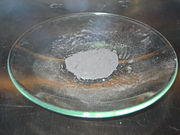Portal:Chemistry/Featured article/8
Raney nickel is a solid catalyst composed of fine grains of a nickel-aluminium alloy, used in many industrial processes. It was developed in 1926 by American engineer Murray Raney as an alternative catalyst for the hydrogenation of vegetable oils in industrial processes. More recently it is used as a heterogeneous catalyst in a variety of organic syntheses, most commonly for hydrogenation reactions.
Raney nickel is produced when a block of nickel-aluminium alloy is treated with concentrated sodium hydroxide. This treatment, called "activation", dissolves most of the aluminium out of the alloy. The porous structure left behind has a large surface area, which gives high catalytic activity. A typical catalyst is around 85-percent nickel by mass, corresponding to about two atoms of nickel for every atom of aluminium. The aluminium which remains helps to preserve the pore structure of the overall catalyst.
Since Raney is a registered trademark of W. R. Grace and Company, only those products by its Grace Davison division are properly called "Raney nickel". Alternatively, the more generic terms "skeletal catalyst" or "sponge-metal catalyst" may be used to refer to catalysts that have physical and chemical properties similar to those of Raney nickel.

